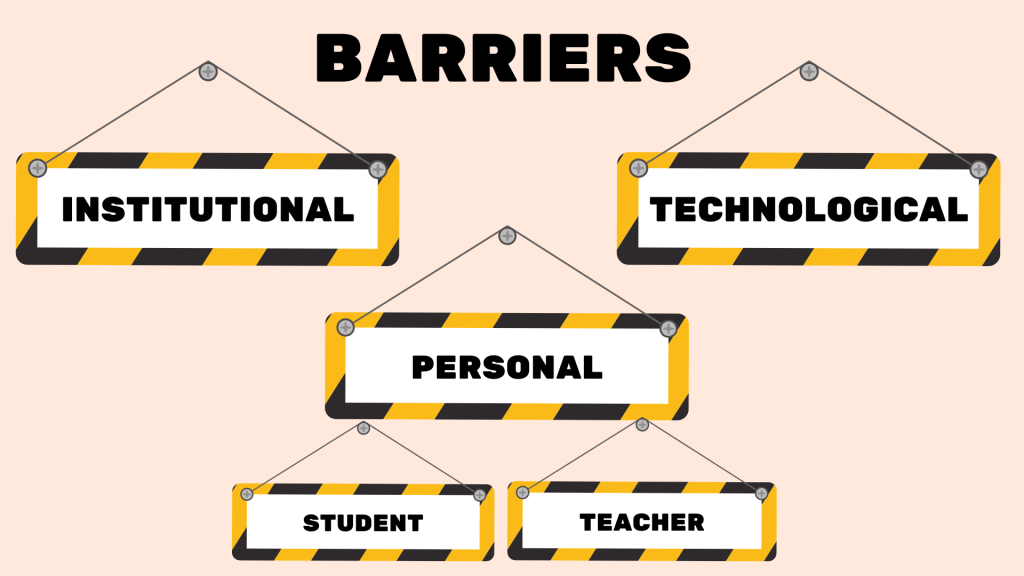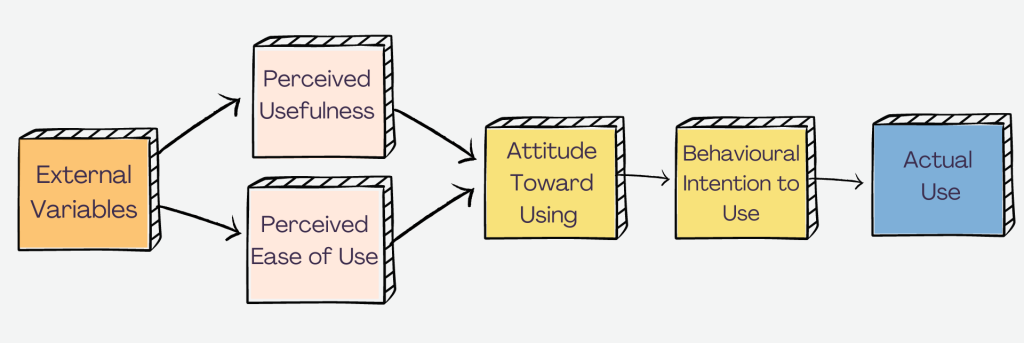Digital Technologies
Overcoming Barriers
HyFlex learning and teaching is exciting. It’s transformative for learning and teaching and might solve a range of problems in our online programs. So, why is HyFlex not more widely adopted?
Barriers and enablers
There are always challenges or barriers when implementing new educational technologies to support learning. We need to solve many of these and find or create enablers. Ultimately, it is important to acknowledge them and find solutions rather than allowing them to stop us from innovating. Including enablers in your planning is critical to future success.
Educational technology research often explores the barriers and enablers with common themes emerging for the Higher Education context. We have aligned these to:
- Institutional – controlled by the institution and sometimes out of the control of the learning designer, academic and/or student. This might include access to the technology as distinct from the actual technologies.
- Technological – the technologies that are available at any given time and in any given context may add a barrier. The institution may provide access to the technology, but it may not be the technology that best facilitates HyFlex.
- Personal – these barriers are varied and may include the individuals’ access, attitude and aptitude.

Institutional
Despite all the best intentions by the institution, it is often the most difficult barrier to address. This is partly due to the many stakeholders involved and partly due to the processes and procedures. In the HyFlex context, the adoption and implementation of new learning and teaching approaches, including the use of alternative educational technologies, requires collaboration between:
- Administrators
- ICT department staff
- Policymakers
- Pedagogical experts
- Discipline experts
Communication and collaboration around HyFlex learning objectives at the broader institution level is crucial for success. Beatty first coined the term ‘HyFlex’ to provide a common language for stakeholders in the institution. He discusses this in HyFlex Course Design Model (Beatty, n.d.). Therefore, the first step in implementing HyFlex in your context is to come to a common understanding that can be communicated to all of the stakeholders.
Things to consider:
These are the essential considerations and discussions to have when moving towards HyFlex learning (or any other related digital transformation) within the institution:
- Infrastructure: what exists and what is required (hardware, edtech software and networking)
- Policies and guidelines: is there willingness to shift in support of new ways of learning
- Teacher capacity: how stressed is the teaching staff and what support will they receive within academic courses and programs
Ideally, HyFlex learning needs to start with a vision for both virtual and physical learning (on-campus and online) and then build from there. Often an institution divides the two modes, on campus is, well, on campus; online means using a tool like Zoom or Engageli to run and record sessions. Combining these tow objectives creates the hybrid situation we shared earlier, and this requires ICT careful setup and pedagogical knowledge to manage the session.
Technological
Technological barriers include institutional (availability and access) and the approach or attitude that individuals have towards technology. Ertmer (1999) described these as first and second-order barriers over 20 years ago, and they persist today. First-order barriers refer to a lack of hardware, software and networking, a lack of time to plan, and inadequate technology and/or administrative support. Second-order barriers are intrinsic to the person and include attitudes and beliefs about the efficacy of digital learning and unwillingness to change. Ertmer’s framing of barriers in this way is useful when you are trying to make a case for the use of technology. The categorisation into first and second order can also help when trying to identify what the barrier is and how it might be addressed.
The institution needs to provide the technology and the “licence” to innovate and experiment with technology. Some institutions are very proprietorial about what can be used, which can restrict innovation. Often, the status quo is easier to maintain through controlled strategies that do not align with innovation or change. In some countries or global areas laws restrict the use of some technologies in order to provide privacy and protect user data. These ‘barriers’ can be difficult to overcome or problem solve. In our experience, there is always a way, keep ideas alive through ongoing discussions and find pathways to success.
One goal is to have a fully integrated virtual campus for students to experience on-campus learning and vice versa. For HyFlex, this includes both synchronous and asynchronous technologies, and therefore these technological aspects need to be addressed:
- Low/poor bandwidth
- Technical support by the institution’s ICT section (helpline) and/or third-party
- Students and staff knowing how to use the technology (include video-based “how to” resources for all newcomers)
Personal: the teacher
As Ertmer (1999) revealed it can often be personal barriers that stop faculty from progressing when it comes to innovative approaches like HyFlex.
Rogers’s (1962) diffusion of innovations is a good representation of the stages of adoption and where people might sit in terms of their willingness to try new approaches. There may be a range of people from laggards to early adopters, but fundamentally, most people are with the late or early majority. These people are willing to adopt innovation once it has been tested out by the early adopters. Rogers first published his work in 1962, and his book is in its 5th edition, referencing more recent innovations.
Other models that help to explain why the teacher may find technology as a barrier is the Technology Acceptance Model (Davis,1989). Davis suggested that for a technology to be accepted, the user needs to recognise its usefulness and ease of use in order to move towards using the technology. This is often described using the graphic below.

A HyFlex Mindset
Much of this points to the individual’s mindset in terms of how open they are to try new things and how willing they are to take a risk and perhaps feel that they have failed (hopefully only at first). We’d like to suggest that there is a HyFlex mindset in which the student is at the centre of learning design, with the provision of authentic and flexible learning for students being the key driver. When we start with this as the premise, then we have the motivation to work through the personal barriers.
Personal: the student
The student may have their own barriers to accepting the HyFlex model, and the teacher may encounter barriers that impact the students. Many students will not be familiar with being given choice and flexibility, which may make them apprehensive and fearful of what that means. If they typically know what they need to do to get a certain grade and have been stepped through processes, then this may be a more comfortable place for them in the learning environment. Students will also be on the innovation scale of laggard to innovator, and teachers will have a cross-section in their classes. What will the level of readiness to accept HyFlex as a student actually be? Trying to ascertain this at the start of your course may be prudent.
While HyFlex is designed to be student-directed at its core, the students may not be ready to do the directing. The work of Gilly Salmon (2011) in her five stage model for online learning is useful reminding us to start small and build up to more complex and open opportunities for the students. She starts with “access and motivation”, leading to “social experiences” that encourage students to develop confidence in the learning ecosystem. Course design that follows the additional stages accounts for “information exchange” and learning community building, “knowledge construction” involving collaboration and a move to teacher facilitation, and “development” of meta-cognition.
Students also need to recognise that some of the technology and approaches we are using may not fit their initial perceptions of a learning experience. They need to trust us to set the scene for effective learning and to support them through the journey. Our role is to help develop that trust so that we can frame their experiences.
For example, what if the student has come to class thinking they just want to sit and get? There are some days when some of us would like to do that too. In a HyFlex model, we can have experiences designed so that on those days, students can choose the level of interaction or participation and at a later date, if they believe they need to, they can come back to other resources and materials. This is a more personalized approach that potentially requires using a range of multimedia that may stretch their comfort zone of technology. For example, using video to be more present in an online space. This might take some time and consideration of what their previous experiences are.
In order to facilitate HyFlex well we must be mindful of student expectations for their learning environments to ensure full engagement through use of contemporary technology available.
References
Beatty, B. (n.d.). HyFlex course design model. https://thinkudl.org/episodes/hyflex-course-design-model-with-brian-beatty
Ertmer, P.A. (1999) Addressing first- and second-order barriers to change: Strategies for technology integration. ETR&D 47, 47–61. https://doi.org/10.1007/BF02299597
Davis, F. D. (1989). Perceived usefulness, perceived ease of use, and user acceptance of information technology, MIS Quarterly (13:3), 319-339.
Rogers, E. M. (1962). Diffusion of innovations (1st ed.). Free Press of Glencoe. OCLC 254636.
Salmon, G. (2011). E-moderating: The key to teaching and learning online (3rd ed.). Routledge. https://www.gillysalmon.com/five-stage-model.html

Media Attributions
- Barriers to technology integration © Lisa Jacka is licensed under a CC BY-NC (Attribution NonCommercial) license
- Technology Acceptance Model © Sun, J.; & Wang, Y. adapted by Lisa Jacka is licensed under a CC BY (Attribution) license
- Overcoming Barriers – Video © Julie Lindsay is licensed under a CC BY-NC (Attribution NonCommercial) license

